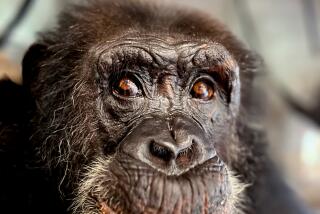There’s No Changing Her Spots
- Share via
Tippi Hedren keeps a mountain lion outside her kitchen, two African wildcats known as servals off her bedroom and a liger, an offspring of a lion and a tiger, behind a fence a few feet from her front porch.
The actress, who starred in Alfred Hitchcock’s “The Birds” (1963) and “Marnie” (1964), also has elephants in her house. Not live ones--they’re part of a collection of jewelry and art. But the cats are real, and an adult elephant does share the grounds.
Hedren lives in the Antelope Valley, 40 miles northeast of Los Angeles, in a wild-animal sanctuary she named Shambala--Sanskrit for a meeting place of peace and harmony for all beings, animal and human.
Home to the actress since the mid-’70s, Shambala is a refuge for about 60 big cats and Timbo, a 45-year-old African bull elephant. All of the cats were born in the U.S. Some were kept as youngsters in private homes. Many were abused.
None should be considered a pet, Hedren said, who first became interested in the plight of wildlife while filming in Africa during the late ‘60s and early ‘70s.
Never mind that she opens a window in her house to let Daisy, the mountain lion, get a drink from the kitchen sink.
Forget that Hedren steps onto the deck and into the yard off her bedroom to summon a serval named Bugs Bunny.
These cats are predators. Asked if she has ever been bitten, Hedren said, “It comes with the territory, but I’ve had no bad bites--I’m still here.”
She and her 11-member staff have learned how to treat the animals “with the dignity and respect they should have,” she said. Of course, gaining that knowledge took time.
Shambala, in Soledad Canyon with a post office box in Acton, was founded by Hedren in 1972, the year Timbo arrived after being evicted from a game park in the Northwest.
Hedren moved to the sanctuary, then on 40 acres on the edge of the Mojave Desert, when her house was built there in 1976. Before that she had lived in Sherman Oaks and Beverly Hills.
Rustically elegant, her Shambala house is decorated in leopard and tiger prints and such Hedren collectibles as stuffed toys of lions and other animals. “I collect everything,” she said.
The one-story house has two bedrooms and two bathrooms in an estimated 3,000 square feet plus outside decking for another 1,000 square feet.
Over the years, Hedren has added onto the house and Shambala, which has the Santa Clara River running through it. Roar, the nonprofit foundation that operates Shambala and is headed by Hedren, recently acquired another 32 acres.
“And I’ve added rooms,” Hedren said. She calls one, which was formerly part of the porch, the Raintree Room “because there is a tree in it, and it rains in here.”
The room also has a love seat and a leopard-print rug, an African mask, lots of plants and a cat tree for her domesticated animals.
Hedren has six house cats. Five have the first and last names of actors in her life: Melanie Griffith, her daughter; Antonio Banderas, Griffith’s husband; Rod Taylor, her co-star in “The Birds”; Marlon Brando, one of her co-stars in “A Countess From Hong Kong” (1967); and John Saxon, her co-star in one of a couple of movies she made in Africa.
Sometimes the cats are taken by “catmobile--as opposed to Batmobile,” Hedren said, to the Shambala gift shop and office for a change of scenery. Most of the time, the cats stay in the house. Signs in both places read: “Please don’t let the cat out, no matter what it tells you.”
Another sign, which marks Hedren’s dressing room, says “Tippi Hedren” on a star like those on the Hollywood Walk of Fame. Her dressing room is big enough to be a bedroom, and in fact was her bedroom until she added on a room with a Dutch door for viewing the large-eared servals, which she sometimes walks on a leash.
Hedren also can see the liger up close from the bedroom window, which her bed faces, often with Rod Taylor--the house cat, not the actor--snoozing on the canopy.
Throughout the house, Hedren has filled walls, tops of credenzas and other furnishings with photos of herself and her extended family.
There are pictures of her famous daughter and son-in-law, snapshots of her three grandchildren and photos of wild animals that Hedren took. Some of her photos and sketches have sold for as much as $1,000 each.
Many are of her favorite Shambala animals, such as Natasha, a tigress. “She lived her whole life with me,” the actress said. Natasha died at 19.
Hedren’s house also has a dining room, family room, sitting room, gift wrapping/sewing room and guest quarters.
There is a detached guest house on the grounds, where Hedren’s daughter has stayed. The guest house, actually a safari tent on a platform, is available to the public for a price.
With a gift of $2,500 to Shambala, which depends on donations to house and feed the animals, a couple can stay overnight on a featherbed in the tent from April to October. The price covers a tour of the preserve, cocktails and a gourmet dinner.
A shower off the guest house has a window. “I put it in so you can watch the tiger and the tiger can watch you,” Hedren said. Diners on the veranda get a view of the elephant. After-dinner conversation is punctuated by the sounds of big cats.
Breakfast brings out the ravens and other birds. Ravens were Hedren’s nemesis in the thriller “The Birds,” but she looks kindly on them now.
The exotic cats and elephant at Shambala stay in their habitats unless taken on walks or to other places, like the makeshift jungle made with fresh boughs and bushes by elephant handler Chris Gallucci, who helped build Hedren’s house.
Among the animals are retired circus and Las Vegas performers, old TV and movie actors and big cats that were considered cute gifts when they were little but too much for their owners to handle as adolescents and adults.
A cheetah born in Oregon with three legs came to Shambala at birth. “We taught her how to stand, how to walk,” Hedren said. “Now she runs.”
Georgie, a black leopard, came to the sanctuary during a divorce. Neither husband nor wife could decide who should get the animal. “They’re still deciding,” Hedren said, “and Georgie has been with us now for 10 years.”
Leo, a lion, was living unhappily in somebody’s basement in Branson, Mo.
A Russian lynx came to Shambala without a name. “So we had a contest,” Hedren said, and the winner was Garvey, sent in by a class of schoolchildren in the Garvey School District in Rosemead. The contest was held through the preserve’s Partners in Education program, designed to inspire students to learn more about saving endangered animals.
Shambala is not a zoo, but it is occasionally open to the public. For groups willing to pay at least $35 a person, the refuge is open about once a month. A donor paying a minimum of $75 a month can attend “Adopt a Wild One Day.” Shambala can be reached on the Web at www.shambala.org or by phone at (661) 268-0380.
Hedren is passionate about her work at the refuge and plans to introduce her Shambala Wild Animal Protection Act to Congress in the fall. The act would require permits and licenses to keep such protected wild animals as lions and tigers. Hedren has lobbied for similar legislation for some time with the intent of ending so-called canned hunting on ranches in states where captive animals are stalked by hunters for sport. She is also against domestic breeding of exotic animals. Shambala does not breed, buy, sell or trade animals.
Though much of her time is spent as an animal activist, Hedren is still an actress. Since she starred in “The Birds” in her 20s, she has appeared on TV as well as in movies, including “Tea With Grandma,” for which she just won a best actress award at the New York Film Festival. She also was in the movie “The Sixth Sense,” the CBS series “The Bold and the Beautiful” and the thriller “Pacific Heights,” co-starring her daughter.
The two were also in the docudrama “Roar” (1981), the namesake of her foundation. “Roar” was directed by Noel Marshall, her second husband.
Hedren has been single now for more than a decade, but she is never alone at home in Shambala.
“I really love my house,” she said, “and I love the animals. I love them all.”


